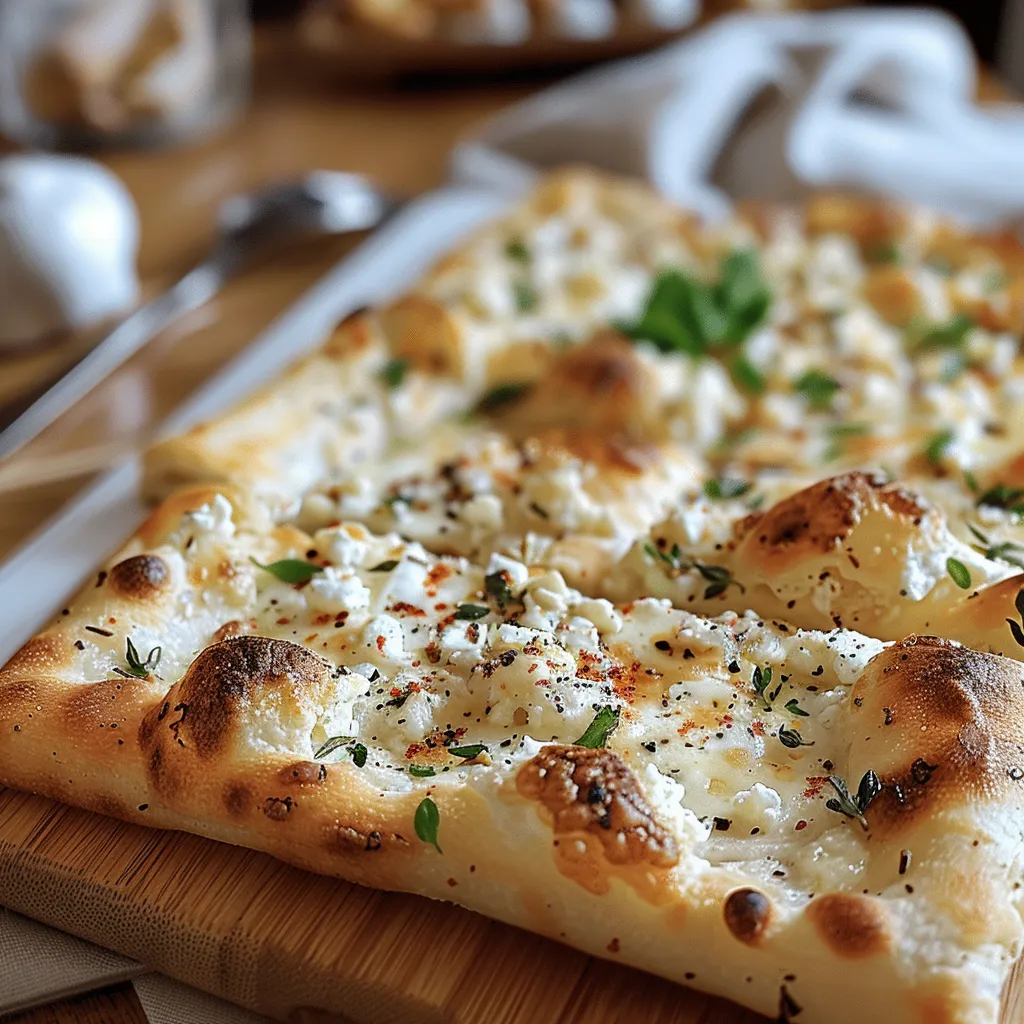Cottage Cheese Flatbread: A Delicious, Easy Recipe

Imagine sinking your teeth into a warm, fluffy flatbread that not only delights the palate but also packs a nutritious punch. Cottage cheese flatbread combines the creaminess of cottage cheese with the wholesome goodness of simple ingredients, making it an irresistible addition to any meal. Whether served alongside savory dips, topped with vibrant vegetables, or enjoyed simply with a drizzle of olive oil, this versatile flatbread can elevate any dining experience.
But don’t stop there! Feel free to explore various flavor profiles by mixing in herbs, spices, or even grated cheese for an extra layer of taste. For those looking to make it gluten-free, experimenting with alternative flours like almond or chickpea can yield delightful results. Additionally, achieving the ideal texture requires careful attention during cooking; using a cast-iron skillet can ensure a perfect golden crust.
Get ready to whip up a batch that’s not just delicious but also a canvas for your creativity in the kitchen!
Ingredients for Cottage Cheese Flatbread:
Main Ingredients:
- 2 cups cottage cheese (well-drained, preferably low-fat or full-fat depending on your preference)
- 3 cups all-purpose flour (plus extra for dusting)
- 1 teaspoon baking powder (to help the flatbread rise slightly)
- ½ teaspoon salt (to enhance flavor)
- 1 large egg (a binder that helps maintain the structure)
- 2 tablespoons olive oil (adds moisture and a pleasant flavor)
- ¾ cup water (adjust as necessary for dough consistency)
Flavor Enhancements:
- 1 teaspoon garlic powder (for a savory kick)
- 1 teaspoon dried oregano (adds an aromatic touch)
- 1 teaspoon onion powder (for added depth of flavor)
- Fresh herbs like chopped parsley or chives (¼ cup for a fresh, vibrant taste)
- ¼ teaspoon black pepper (for a mild heat)
Optional Toppings:
- ¼ cup grated Parmesan cheese (for a cheesy crust)
- 1 cup shredded mozzarella cheese (for a gooey texture)
- Assorted vegetables such as bell peppers, spinach, or olives (1-2 cups total, chopped)
- Seeds like sesame or poppy (for a crunchy topping)
Variations:
- For a whole grain option, replace half of the all-purpose flour with whole wheat flour.
- Substitute Greek yogurt for cottage cheese for a different flavor and creaminess.
- For a spicy version, add jalapeños or crushed red pepper flakes to the dough.
- Experiment with different herbs and spices to create seasonal flavors; rosemary or thyme work beautifully.

How to prepare Cottage Cheese Flatbread:
Making Cottage Cheese Flatbread is simple and satisfying. Follow these step-by-step instructions to create a delicious flatbread that pairs perfectly with a variety of dishes.
Gather Your Ingredients
Begin by collecting all the necessary ingredients. You’ll need:
- 1 cup cottage cheese
- 1 cup all-purpose flour (plus extra for dusting)
- 1 large egg
- 1/2 teaspoon baking powder
- 1/4 teaspoon salt
- 1 tablespoon olive oil
- Optional: herbs or spices for flavor
Mix the Wet Ingredients
In a medium-sized mixing bowl, add the cottage cheese and egg. Use a fork or whisk to blend these ingredients together until they are smooth and well combined. This combination forms a rich, creamy base for the flatbread.
Combine the Dry Ingredients
In a separate bowl, whisk together the flour, baking powder, and salt. Mixing these dry ingredients first ensures even distribution of the baking powder and salt throughout the flatbread.
Combine Wet and Dry Ingredients
Pour the cottage cheese mixture into the bowl containing the dry ingredients. Gently fold the mixture using a spatula. Ensure that all flour is moistened, but avoid overmixing, as this can make the flatbread tough.
Add Olive Oil
Drizzle the olive oil into the dough. This step enriches the flatbread’s texture. Mix gently until the oil is fully incorporated, adding a touch of flavor and moisture.
Knead the Dough
Turn the dough out onto a lightly floured surface. Knead it gently for about 2 minutes just until it comes together. This kneading process develops the dough’s gluten, creating a more elastic flatbread.
Roll Out the Dough
Divide the dough into equal portions based on your preferred size of flatbreads. Take one portion and roll it out to about 1/4-inch thickness. Use flour as needed to prevent sticking.
Cook the Flatbreads
Preheat a non-stick skillet over medium heat. Place the rolled-out flatbread in the skillet. Cook for 2-3 minutes on each side until golden brown and cooked through. Repeat this process with the remaining dough.
Serve and Enjoy
Once cooked, remove from the skillet and let them cool slightly. Serve warm with dips, or use them as a base for wraps. Enjoy your homemade creation!
Tips for the Perfect Cottage Cheese Flatbread
Use Quality Ingredients
To achieve the best flavor and texture in your flatbread, start with high-quality ingredients. Choose fresh, full-fat cottage cheese to enhance creaminess. Look for flour that is unbleached and provides a good protein content; this will give your bread a nice structure. Fresh herbs and spices can also elevate the taste, so opt for dried herbs like oregano or fresh parsley as you mix your dough.
Maintain the Right Temperature
Temperature plays a vital role in baking. Make sure all ingredients, especially the cottage cheese and water, are at room temperature. Cold ingredients can lead to uneven mixing and impact the bread’s texture. If your kitchen is too cool, consider warming your mixing bowl slightly with warm water before you start. Similarly, preheat your oven adequately; a hot oven ensures that the bread rises and bakes properly.
Perfect Your Dough Consistency
When making your dough, it’s important to achieve the right balance. Avoid adding too much flour initially; a slightly sticky texture allows for better moisture retention. If the dough becomes too sticky during the kneading process, sprinkle a small amount of flour gradually until it becomes manageable. Resting the dough for 10-15 minutes can also help develop gluten, which contributes to a better rise.
Substitutions for Dietary Restrictions
Accommodating dietary restrictions does not mean sacrificing taste. For a gluten-free version, substitute traditional flour with almond flour or a commercial gluten-free blend designed for baking. If you need a dairy-free option, replace cottage cheese with a vegan alternative made from soy or nuts. Using avocado or mashed bananas can add a similar creaminess to the dough while keeping it plant-based.
Experiment with Flavors
Don’t hesitate to play with flavors in your flatbread. Incorporate garlic powder, chili flakes, or even a sprinkle of cheese for a savory touch. For a sweet variation, mix in a bit of cinnamon and serve the bread with honey or fresh fruit. Adding a drizzle of olive oil before baking enhances the crust’s flavor and promotes a golden-brown finish.
Storage Tips for Leftovers
If you have remaining flatbread, store it properly to retain freshness. Seal it in an airtight container or wrap it in plastic wrap. Refrigerating will extend its life to about a week, while freezing can preserve it for up to three months. To reheat, pop it in the oven or a skillet for a few minutes until warm and crispy again.
Storage Tips for Cottage Cheese Flatbread:
Proper storage greatly enhances the freshness and longevity of your flatbread. By following a few simple guidelines, you can ensure that your Cottage Cheese Flatbread remains delicious for an extended period. Here are effective strategies to keep it at its best.
Cooling Down Before Storage
Before storing your flatbread, let it cool completely. Placing warm flatbread directly into storage containers can trap moisture, leading to sogginess. Allowing it to cool on a wire rack prevents condensation, preserving the texture.
Use Airtight Containers
For optimal freshness, store your flatbread in airtight containers. This method minimizes exposure to air, which can cause it to dry out or become stale. Choose containers or resealable plastic bags that fit the flatbread snugly to avoid excess air space.
Refrigeration for Short-term Storage
If you plan to consume your flatbread within a week, refrigerate it. Just ensure you wrap it tightly in plastic wrap or aluminum foil before placing it in an airtight container. This practice helps maintain its flavor and texture. The chilled environment also inhibits mold growth, keeping your flatbread safe and tasty.
Freezing for Long-term Storage
Freezing is an excellent option for extending shelf life beyond a week. Slice the flatbread into pieces for easier thawing. Wrap each piece tightly with plastic wrap, then place all the wrapped pieces into a freezer bag. Label the bag with the date and store it in the freezer. Your flatbread will last up to three months frozen, retaining its quality when thawed.
Thawing and Reheating
When you’re ready to enjoy your frozen flatbread, remove it from the freezer and let it thaw in the refrigerator overnight. For quicker thawing, place it at room temperature for a couple of hours. Reheat your flatbread in a toaster oven or skillet to restore its texture. A quick reheating will bring back that fresh-baked taste.
Check for Signs of Spoilage
Always inspect your flatbread before consuming. Look for any off smells, changes in color, or mold growth. If you notice any of these signs, it’s best to discard the flatbread to ensure safety.
By following these storage tips, you will maximize the freshness and enjoyment of your Cottage Cheese Flatbread. Keep these practices in mind to savor every delicious bite!
Related Recipes for Cottage Cheese Flatbread
If you enjoy making cottage cheese flatbread, you will likely love these related recipes. Each of them shares similar ingredients or techniques, making them great companions in your cooking journey.
- Herbed Yogurt Flatbread: This recipe features yogurt, which provides a tangy flavor and a soft texture similar to cottage cheese. Both recipes are versatile and can be easily customized with your favorite herbs and spices. Try adding rosemary or oregano to enhance the aroma while baking.
- Zucchini Fritters: These fritters utilize grated zucchini mixed with cheese, similar to how cottage cheese adds moisture and richness to flatbread. They offer a delightful crispy texture and can serve as a tasty snack or appetizer. Pair them with a tangy yogurt dip for a refreshing bite.
- Cheese Quesadillas: Another cheese-based recipe, cheese quesadillas use melted cheese for a gooey center. Like flatbread, they are quick to prepare and are perfect for utilizing leftover veggies or proteins. They also make a wonderful option for a simple weeknight dinner.
- Baked Spinach and Feta Pies: These pies use a flaky dough filled with a mixture of cheeses and spinach. If you enjoy the creamy texture of cottage cheese flatbread, you’ll appreciate the richness that feta brings to this dish. Serve them alongside a fresh salad for a complete meal.
- Potato and Cheese Pierogi: These dumplings are stuffed with a savory mixture of potatoes and cheese, reminiscent of the comforting elements in cottage cheese flatbread. They are hearty and filling, making them a satisfying choice for lunch or dinner.
Each of these recipes complements the experience of making and enjoying flatbread. They invite creativity and allow you to explore various flavors in your kitchen.
Frequently Asked Questions:
What is Cottage Cheese Flatbread?
Cottage cheese flatbread is a simple, soft bread made primarily with cottage cheese, flour, and a handful of seasonings. It’s typically easy to prepare and can be served warm or cold, making it a versatile choice for various meals. The cottage cheese adds a unique texture and a delightful protein boost, creating a nourishing flatbread option.
How do I make Cottage Cheese Flatbread from scratch?
To create your own version of this unique flatbread, combine cottage cheese with your choice of flour, a bit of baking powder, and your favorite herbs or spices in a mixing bowl. Knead the dough lightly until it reaches a pliable consistency, then roll it out into flat discs. Cook on a skillet or griddle until golden brown on both sides.
Can I use whole wheat flour instead of all-purpose flour?
Yes, whole wheat flour can be substituted for all-purpose flour when making this delicious flatbread. Keep in mind that this will give the bread a heartier texture and a slightly nutty flavor, which can complement the cottage cheese beautifully.
Is this flatbread suitable for vegan diets?
Traditional cottage cheese flatbread contains dairy, making it unsuitable for vegan diets. However, you could create a vegan alternative by using plant-based cottage cheese or a similar substitute made from tofu blended with some nutritional yeast and lemon juice for added flavor and creaminess.
How do I store leftover Cottage Cheese Flatbread?
To store leftover flatbread, let it cool completely before wrapping it in plastic wrap or placing it in an airtight container. It can be kept in the refrigerator for up to three days. If you want to extend its shelf life, consider freezing it. Simply place layers of parchment paper between the flatbreads and keep them in a freezer bag for later use.
What are some toppings or fillings I can use with Cottage Cheese Flatbread?
This flatbread is incredibly versatile and can be paired with a variety of toppings. Consider using avocado, fresh veggies, hummus, or even sliced meats. For a sweet twist, try spreading some honey or fruit preserves topped with nuts. The options are endless, allowing you to enjoy it for breakfast, lunch, or dinner.
Conclusion:
Cottage cheese flatbread offers a remarkable blend of simplicity and versatility, making it a perfect addition to your culinary repertoire. This easy-to-follow recipe not only requires minimal ingredients but can also be customized to fit your unique taste preferences. You can experiment with various herbs, spices, and add-ins, transforming this flatbread into a personalized delight that suits any occasion. The light and fluffy texture pairs wonderfully with dips, toppings, or as a base for wraps. Remember, the key to achieving the perfect flatbread lies in the balance of moisture and flour, so feel free to adjust as you go. Embrace the flexibility of cottage cheese flatbread, allowing your creativity to take center stage while enjoying a nutritious and delicious meal. Whether you serve it as a snack, side, or main dish, this delightful treat will surely impress your family and friends.
Print
Cottage Cheese Flatbread: A Delicious, Easy Recipe
- Total Time: 16 minute
- Yield: 4 flatbreads 1x
Description
This high-protein, soft, and flavorful cottage cheese flatbread is perfect for wraps, sandwiches, or as a side for soups and dips. It’s easy to make, packed with nutrients, and requires just a few simple ingredients!
Ingredients
- 1 cup cottage cheese
- 1 cup all-purpose flour (or whole wheat flour)
- ½ tsp baking powder
- ½ tsp salt
- 1 tbsp olive oil
- 1 egg (optional, for extra protein & texture)
Instructions
1️⃣ Prepare the Dough:
- Blend cottage cheese in a food processor until smooth.
- In a bowl, mix flour, baking powder, and salt. Add blended cottage cheese and olive oil.
- Stir until a dough forms, then knead for 2-3 minutes until soft. If sticky, add a little more flour.
2️⃣ Shape the Flatbreads:
- Divide the dough into 4 equal portions and roll each into a thin, round shape.
3️⃣ Cook to Perfection:
- Heat a non-stick pan over medium heat.
- Cook each flatbread for 2-3 minutes per side, until golden brown and slightly puffy.
4️⃣ Serve & Enjoy:
- Serve warm with hummus, tzatziki, or as a base for pizzas and wraps!
Notes
✔️ For gluten-free: Use almond or oat flour instead of all-purpose flour.
✔️ For a herby twist, add garlic powder, dried oregano, or chopped parsley to the dough.
✔️ Store in an airtight container for 2 days or freeze for later use.
- Prep Time: 10 minutes
- Cook Time: 10-12 minutes
Nutrition
- Calories: 150 kcal
- Fat: 5g
- Carbohydrates: 18g
- Protein: 8g
